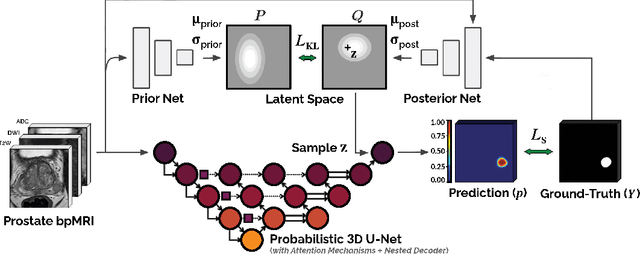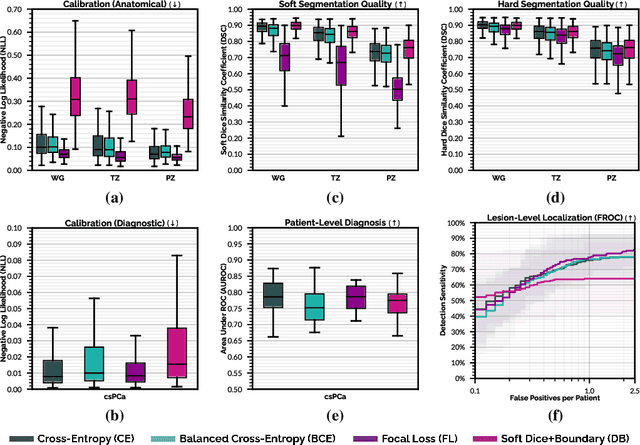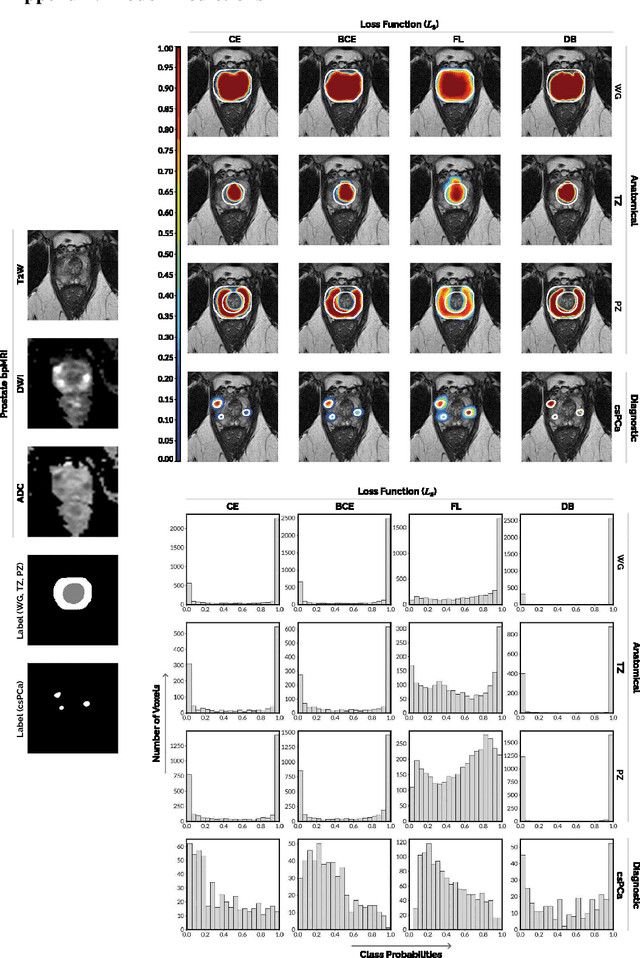Jasper Linmans
Anatomical and Diagnostic Bayesian Segmentation in Prostate MRI $-$Should Different Clinical Objectives Mandate Different Loss Functions?
Oct 25, 2021


Abstract:We hypothesize that probabilistic voxel-level classification of anatomy and malignancy in prostate MRI, although typically posed as near-identical segmentation tasks via U-Nets, require different loss functions for optimal performance due to inherent differences in their clinical objectives. We investigate distribution, region and boundary-based loss functions for both tasks across 200 patient exams from the publicly-available ProstateX dataset. For evaluation, we conduct a thorough comparative analysis of model predictions and calibration, measured with respect to multi-class volume segmentation of the prostate anatomy (whole-gland, transitional zone, peripheral zone), as well as, patient-level diagnosis and lesion-level detection of clinically significant prostate cancer. Notably, we find that distribution-based loss functions (in particular, focal loss) are well-suited for diagnostic or panoptic segmentation tasks such as lesion detection, primarily due to their implicit property of inducing better calibration. Meanwhile, (with the exception of focal loss) both distribution and region/boundary-based loss functions perform equally well for anatomical or semantic segmentation tasks, such as quantification of organ shape, size and boundaries.
Improved and Robust Controversy Detection in General Web Pages Using Semantic Approaches under Large Scale Conditions
Dec 02, 2018



Abstract:Detecting controversy in general web pages is a daunting task, but increasingly essential to efficiently moderate discussions and effectively filter problematic content. Unfortunately, controversies occur across many topics and domains, with great changes over time. This paper investigates neural classifiers as a more robust methodology for controversy detection in general web pages. Current models have often cast controversy detection on general web pages as Wikipedia linking, or exact lexical matching tasks. The diverse and changing nature of controversies suggest that semantic approaches are better able to detect controversy. We train neural networks that can capture semantic information from texts using weak signal data. By leveraging the semantic properties of word embeddings we robustly improve on existing controversy detection methods. To evaluate model stability over time and to unseen topics, we asses model performance under varying training conditions to test cross-temporal, cross-topic, cross-domain performance and annotator congruence. In doing so, we demonstrate that weak-signal based neural approaches are closer to human estimates of controversy and are more robust to the inherent variability of controversies.
Sample Efficient Semantic Segmentation using Rotation Equivariant Convolutional Networks
Jul 02, 2018


Abstract:We propose a semantic segmentation model that exploits rotation and reflection symmetries. We demonstrate significant gains in sample efficiency due to increased weight sharing, as well as improvements in robustness to symmetry transformations. The group equivariant CNN framework is extended for segmentation by introducing a new equivariant (G->Z2)-convolution that transforms feature maps on a group to planar feature maps. Also, equivariant transposed convolution is formulated for up-sampling in an encoder-decoder network. To demonstrate improvements in sample efficiency we evaluate on multiple data regimes of a rotation-equivariant segmentation task: cancer metastases detection in histopathology images. We further show the effectiveness of exploiting more symmetries by varying the size of the group.
Rotation Equivariant CNNs for Digital Pathology
Jun 08, 2018



Abstract:We propose a new model for digital pathology segmentation, based on the observation that histopathology images are inherently symmetric under rotation and reflection. Utilizing recent findings on rotation equivariant CNNs, the proposed model leverages these symmetries in a principled manner. We present a visual analysis showing improved stability on predictions, and demonstrate that exploiting rotation equivariance significantly improves tumor detection performance on a challenging lymph node metastases dataset. We further present a novel derived dataset to enable principled comparison of machine learning models, in combination with an initial benchmark. Through this dataset, the task of histopathology diagnosis becomes accessible as a challenging benchmark for fundamental machine learning research.
 Add to Chrome
Add to Chrome Add to Firefox
Add to Firefox Add to Edge
Add to Edge